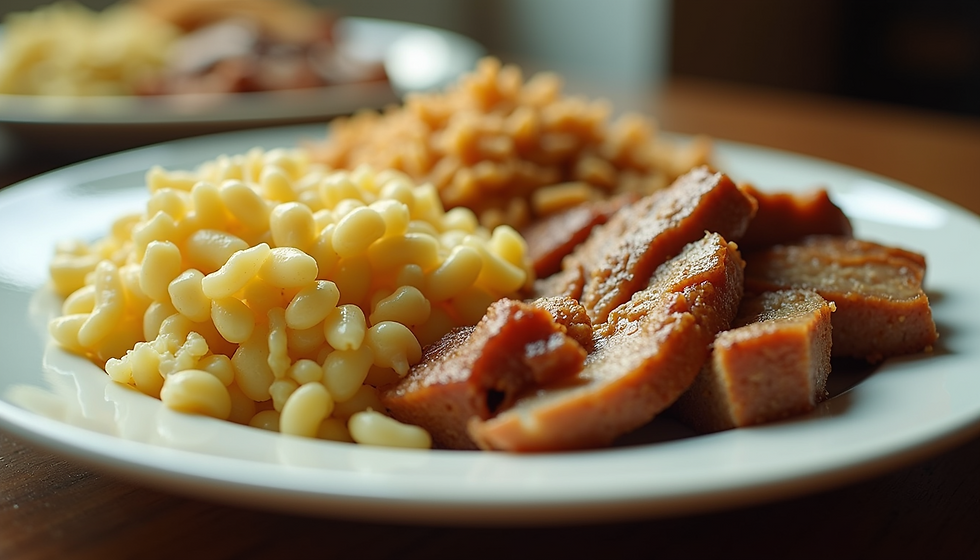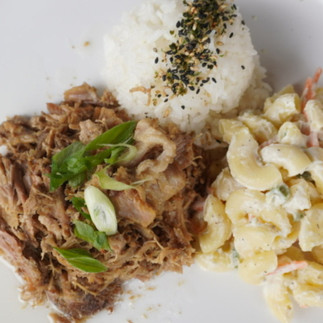Hawaiian Food Beyond Poké
- Kalei's Kitchenette

- Sep 4
- 5 min read
Let’s be real. When most people in San Diego say they’re “craving Hawaiian,” what they really mean is they want a poké bowl. And while there’s nothing wrong with fresh ahi tossed in shoyu, the truth is, Hawaiian food goes way beyond poké.

From hearty plate lunches to smoky kalua pork and buttery pork lau lau, traditional Hawaiian cuisine is rich, soulful, and shaped by a mix of cultures. Still, most food roundups barely scratch the surface.
It’s time to expand the conversation and your appetite.
What Is Real Hawaiian Food?

Authentic Hawaiian food is all about community, comfort, and simplicity. It blends native island ingredients with flavors brought over by generations of immigrants including Japanese, Chinese, Filipino, Korean, Portuguese, and more, who helped shape the islands' identity through food.
Here are just a few staples of a real Hawaiian meal:
From Left to right
Kalua Pork
Slow-roasted, smoky shredded pork paired with rice and mac salad
Huli Huli Chicken
Marinated in a smoky and savory sauce, grilled to perfection
Spam Musubi
A handheld snack with seared Spam, teriyaki sauce, rice, and nori
From Left to right
Loco Moco
A comfort classic with a hamburger patty over rice, topped with eggs and brown gravy
Lau Lau
Taro leaves wrapped around pork or fish, steamed until tender
Plate Lunch
A combo of one main protein, two scoops of rice, and creamy mac salad
Some neighborhood kitchens in San Diego are keeping these traditions alive. One local spot in Rancho Peñasquitos occasionally rolls out a limited-run pork lau lau, made with taro leaves flown in from Hawaii. It’s not on the regular menu. Only ten are made when it drops. Blink and you’ll miss it, but the regulars know when to show up.
Let’s Talk About Poké
Poké is easily the most recognized Hawaiian dish and for good reason. Traditionally, it's made with cubes of raw fish, usually ahi tuna, marinated in shoyu, sesame oil, sweet onions, and sometimes seaweed. It's simple, savory, and satisfying.

Over time, especially on the mainland, poké has evolved into build-your-own bowls topped with everything from mango and edamame to crispy onions and spicy mayo. It’s different from how it’s served in Hawaii, but it reflects the diversity of tastes here.
There’s nothing wrong with loving poké. Just don’t forget it’s one part of a much bigger story.
The heart of Hawaiian food is about balance. Warm, hearty dishes, smoky meats, sweet and savory marinades, and that classic plate lunch setup that ties it all together.
So yes, enjoy the poké bowl. But don’t sleep on what else is simmering in the kitchen.
The Hawaiian Plate Lunch: Underrated and Delicious

If Hawaiian food had a signature dish, it would be the plate lunch. It’s humble, filling, and always hits the spot. One or two proteins, two scoops of rice, and a scoop of creamy mac salad. That’s it. No fuss. Just flavor and comfort, island-style.
Born from Hawaii’s plantation days, the plate lunch is a mix of influences including Japanese, Filipino, Portuguese, Chinese, and more, all packed into one container. You’ll often find:
Kalua Pork: Tender, smoky, and fall-apart good
Huli Huli Chicken: Sweet, tangy, and grilled
Chicken Katsu: Crispy breaded chicken with tangy katsu sauce
Loco Moco: Hamburger patty over rice with egg and gravy
Garlic Chicken: Crispy, sticky, and savory
It’s not just food. It’s comfort. The kind that reminds you of backyard BBQs, family parties, and beach lunches under palm trees.
And while plate lunch spots may not be as flashy as modern poké chains, they’re where the soul of Hawaiian cooking lives. Some local kitchens are even giving them a twist like Filipino-style adobo, garlic rice, or fusion mashups that actually work.
Hawaiian Fusion Is a Vibe
Hawaiian food has always been a blend, and that’s what makes it special. In recent years, Hawaiian fusion has taken that foundation and added bold, creative spins.

You might see:
Kalua pork with Filipino garlic rice
Spam musubi with unagi sauce and furikake
Huli huli chicken skewers grilled just right
Teriyaki beef tucked into bao buns
It’s still rooted in aloha, but it speaks a few more languages.
Fusion isn’t about reinventing Hawaiian food. It’s about evolving it with care. Chefs with Filipino, Korean, Japanese, and multiethnic backgrounds are blending their stories and cultures into the food they serve. And it shows up in kitchens where every dish feels intentional and full of heart.
San Diego has a handful of spots doing this well. They’re often family-run, community-driven, and quietly creating some of the most interesting plates in town.
FAQs About Hawaiian Food
What’s the difference between Hawaiian food and poké?
Poké is just one part of Hawaiian cuisine. It’s often a side dish or appetizer. Hawaiian meals usually include cooked dishes like kalua pork, huli huli chicken, and loco moco, often served as a plate lunch with rice and mac salad.
What’s in a typical Hawaiian plate lunch?
One or two proteins (like kalua pork, chicken katsu, teriyaki beef)
Two scoops of white rice
One scoop of creamy mac salad
Some places offer add-ons like garlic rice or fusion-style sides.
Is Hawaiian food spicy?
Not usually. Most dishes lean sweet, smoky, or savory. But if you like spice, many places offer chili water, sriracha, or spicy house-made sauces on the side.
Are there vegetarian or gluten-free options?
Yes. Some kitchens offer tofu katsu, veggie stir-fry, or naturally gluten-free options like kalua pork. It’s best to check with the restaurant for substitutions.
Can I cater Hawaiian food for my next party?
Absolutely. Hawaiian food is perfect for groups. Big portions, crowd-pleasing flavors, and it travels well. Many local kitchens offer catering trays and event packages.
Where to Get Hawaiian Food in San Diego
San Diego has plenty of spots to grab a poké bowl. But if you’re looking for the full Hawaiian experience, here’s what to look for:
Daily plate lunch specials
Scratch-made dishes
Small-batch items like pork lau lau or garlic shrimp
A mix of cultural influences
Catering options for parties and events
There’s a neighborhood kitchen tucked away in Rancho Peñasquitos that checks all the boxes. What started as a farmers market stand has grown into a go-to for plate lunches, musubi, and party trays. If you catch them on the right day, you might even find a rare batch of pork lau lau with imported taro leaves.
In a city full of food trends, it’s easy to stick with what’s familiar. But if you’re craving the deeper flavors of Hawaiian food, you might just find them in the places that feel a little more like home.
Conclusion
Hawaiian Food Deserves More Than Just a Poké Bowl
San Diego’s food scene is stacked, but when it comes to Hawaiian cuisine, it pays to dig deeper. Poké is popular for a reason, but it’s just the start.
From smoky kalua pork to crispy garlic chicken and that perfect scoop of mac salad, Hawaiian food is all about balance, comfort, and connection.
Whether you're after a quick plate lunch, a nostalgic taste of home, or bold flavors that blend tradition and creativity, San Diego has a few hidden gems that deliver the real thing. No hype, just flavor.
So next time you're hungry, think beyond the bowl. You might just find your new favorite spot.
















Comments